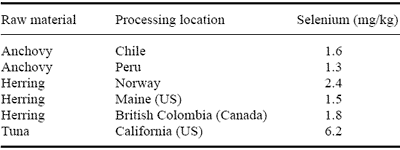Organic Selenium as a Supplement for Atlantic Salmon: Effects on Meat Quality
In Latin America aquaculture production is oriented toward supplying the export market. Exportation of fish and shrimp are major industries in Chile, Peru, Argentina, Uruguay and Ecuador. Ecuador and Chile lead Latin America in aquaculture; and in Ecuador it is the third most important economic industry.
Chilean aquaculture is mainly concerned with production of trout, coho and Atlantic salmon. This rapidly developing sector of the economy produced just 4,200 tons for export in 1988 but in the 10 years since has grown remarkably.
Production in 1997 was 160,000 tons, a 30% increase over 1996. This represented US$670 million. In 1998, Chile is the second largest producer of salmon after Norway.A production of 200,000 tons for export is projected for the year 2000.
Feed for salmon in Chile is comprised of 50% fish meal, 19% fish oil, 20% wheat by-product with the balance made of 0.08 to 0.12% vitamins, minerals and carotenoid pigments. Feed represents about 65% of total production cost. Though pigments are only a small percentage of the diet by weight, they contribute between 20 and 30% of the cost.
Selenium, an essential mineral for salmonids, is important for pigment deposition and flesh color expression. The following paper describes the role of selenium in fish diets and the use of organic selenium supplements in improving meat quality in practical diets.
Bioavailability of inorganic and organic selenium sources for fish
Selenium is required in the diet for normal growth and physiological function of fish. Deficiencies are associated with low glutathione peroxidase (GSHPx) activity, slow growth and exudative diathesis in rainbow trout (Hilton et al., 1980; Bell et al., 1987). The dietary requirement for selenium (supplied as sodium selenite) for normal growth has been calculated at 0.38 mg/kg for rainbow trout while levels of 13 mg/kg have been found to be toxic (Hilton et al., 1980; Gatlin and Wilson, 1984).
It has been assumed that the selenium requirement for fish consuming diets high in fish meal, such as Atlantic salmon, can be met with the selenium present in the fish meal. The validity of this assumption depends, however, on the selenium content of the fish meal which varies with source and type of processing.
The type of raw material used to make fish meal can have a large impact on final selenium content (Table 1).
Table 1. Selenium content of fish meals made from different raw materials.
The primary role of selenium in fish is as a component of the enzyme GSHPx, which is recognized for its antioxidant protective function. Through its function in GSH-Px selenium aids in minimizing the destructive effects of the oxidative and peroxidative reactions in the cell. Different forms of GSH-Px exist in different tissues and locations in cells. For example, phospholipid hydroperoxide GSH-Px is involved in antioxidant activity in the cell membrane whereas cytosol GSH-Px acts in the cell cytosol.
Selenium supplementation is necessary for both aquaculture species fed diets based on grain and oilseed products such as catfish and tilapia and for species fed fish meal-based diets which do not contain adequate amounts of selenium. The most commonly used forms of selenium supplements to date have been inorganic compounds, sodium selenite and sodium selenate. Selenium from these supplements is passively absorbed from the gut and then reduced in the liver where it is incorporated into cysteine to form selenocysteine.
Organically complexed forms of selenium including the selenium in fish meal and that in selenium yeast have been evaluated comparatively in diets for fish. Organic minerals in general have a higher rate of absorption and a higher rate of retention than inorganic forms (Ashmead and Zunio, 1992).
In a digestibility trial with Atlantic salmon Bell and Cowey (1989) found that availability of selenium from selenomethionine was highest (91.6%) followed by sodium selenite (63.9%) and selenium in fish meal (46.6%). Studies with catfish revealed that selenomethionine was more available than sodium selenite in both a purified egg white-based diet (90.8 vs 62.8%) and in a soybean meal-based diet (88.9 vs. 69.7%) (Paripatananont and Lovell, 1996).
More recently, Lovell and Wang (1997) found that selenium yeast (Sel- Plex 50), a commercially available organic selenium supplement containing primarily selenomethionine and other selenoproteins, had similar bioavailabilty to purified selenomethionine when evaluated using several criteria (Table 2).
When using plasma GSH-Px as the criterion, bioavailability of the organic forms was only 116% relative to sodium selenite; however, when weight gain, liver GSH-Px or liver or muscle selenium were considered both organic forms were 1.5 to more than 4 times more available.
Table 2. Relative bioavailability of purified selenomethionine and selenium yeast (Sel-Plex 50) for catfish using several criteria.
Lovell and Wang, 1997.
*Relative to sodium selenite.
Effects of selenium yeast on salmon flesh quality measurements
While the value of organically complexed selenium such as that in yeast has been conclusively demonstrated for fish fed grain/oilseed-based diets that are naturally low in selenium, little information exists to evaluate organic selenium sources for practical diets fed carnivorous species. In an experiment under commercial conditions in Chile selenium yeast was evaluated as a means of improving three selenium-related quality factors: flesh color, pigment deposition and flesh texture.
PROCEDURES
One hundred forty Atlantic salmon initially weighing 2.6 kg were allocated to two sea pens for the 30 day feeding trial. All fish came from the same origin and were fed at the same rate. The pelleted basal diet contained 47% crude protein and 16% fat. The diet fed the control pen contained fish meal as the sole source of selenium while the diet given the test group contained organic selenium (Sel-Plex 50) at a rate to supply 0.25 mg/kg selenium.
Body weight, length, gutted body weight, sex and maturity state were evaluated on a sample of 20 fish prior to beginning the experiment. Flesh oil content, pigment and Roche flesh color were also evaluated. Following 30 days on the test diets 12 fish from each pen of the same maturity were slaughtered and evaluated. In addition to the previously mentioned parameters, serum GSH-Px was measured.
RESULTS
Supplementation of the salmon diet with selenium yeast had no effect on weight gain but improved flesh quality measurements (Table 3). Flesh color improved by 0.3 Roche points. Flesh texture also improved, increasing from 11.4 to 12.5 kg/cm2. Flesh oil content was lower in fish given Sel-Plex 50 while GSH-Px activity more than doubled. Of particular importance was the increase in pigment deposition noted in response to organic selenium supplementation. The 10.45% increase in pigment deposition provides a means of reducing pigment cost in practical diets.
Table 3. Effect of Sel-Plex 50 (selenium yeast) on flesh quality measurements of Atlantic salmon.
References
Ashmead, H.D. and H. Zunio. 1992. Factors which affect the intestinal absorption of minerals. In: The Roles of Amino Acid Chelates in Animal Nutrition (H.D. Ashmead, ed). Noyes Publication, Park Ridge, NJ. pp. 21–46.
Bell, J.G. and C.B. Cowey. 1989. Digestibility and bioavailability of dietary selenium from fish meal, selenite, selenomethionine and selenocysteine in Atlantic salmon parr (Salmo salar). Aquaculture 81:61–68.
Bell, J.G., C.B. Cowey, J.W. Adron and B.J.S. Pirie. 1987. Some effects of selenium deficiency on enzyme activities and indices of tissue peroxidation in Atlantic salmon parr (Salmo salar). Aquaculture 65:43–54.
Gatlin, M.D. and R.P.Wilson. 1984. Dietary selenium requirement of fingerling channel catfish. J. Nutr. 114:627–633.
Hilton, J.W., P.V. Hodson and S.J. Slinger. 1980. The requirement and toxicity of selenium in rainbow trout (Salmo gairdneri). J. Nutr. 110:2527–2535.
Lovell, R.T. and C.Wang. 1997. Comparison of organic and inorganic sources of selenium for growth and health of channel catfish. In: Biotechnology in the Feed Industry, Proceedings of the 13th Annual Symposium (T.P. Lyons and K.A. Jacques, eds). Nottingham University Press, Loughborough, Leics, UK.
Paripatananont, T. and R.T. Lovell. 1996. Comparative digestibility of chelated and inorganic trace minerals in channel catfish (Ictalurus punctatus) diets. Proceedings of the VII International Symposium on Fish Nutrition and Feeding. p. 24.


United States




